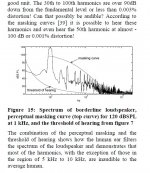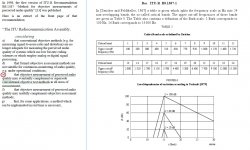Interesting, they measured the response curve on a simulated loudspeaker. It shows what we knew. That the influence of the impedance curve of the load on the amp response curve, due to his internal impedance. (I know the range is ridiculously low) The resistance of the wire increase this effect, and that explain why some can spend hours and half of the budget of the year to compare loudspeaker's cables.Parasound A21 some misure http://www.avhub.com.au/images/stories/pdf/ParasoundP3&HaloA21HFMar08.pdf
We are able to 'feel' very little changes in response curves when a large spectrum is affected.
We can conclude that all reviews about this passionating subject of cables are just jokes, because this cable, supposed to carry more trebles on this loudspeaker, will carry more medium on this other.
Comparing a red Ferrari with a white "vector" stripe to a black Gran Torino, they conclude that red color is faster than the black one.
Thus, audiophiles will buy red Hondas (car of the year) with a white "vector" stripe and be ridiculous in all circumstances.
Last edited:
Care to share with the heretics here?
What is your favorite color?
Seriously, I convinced myself but I probably shouldn't publish on it until I've done a bit more work.
Did-you mean the preamp is provided with this kind of winch to tune up the volume ?I went down to 1 input and a 10 turn wirewound pot.
Repeat the test with a correlated distorted copy of the original and you'll be surprised.
Something very close to this (non random and correlated)
(from: AES E-Library Practical Measurement of Loudspeaker Distortion Using a Simplified Auditory Perceptual Model )
George
Attachments
Yeah that's what I assumed too - in which case not similar to the 'voice in the crowd', rather the whole crowd.
Except in a Souza band I would expect an occasional trombone or trumpet to stand out. Maybe someone should mix in Pavarotti at -60dB? 😛
Something very close to this (non random and correlated)
(from: AES E-Library Practical Measurement of Loudspeaker Distortion Using a Simplified Auditory Perceptual Model )
George
For the smooth distortion of a loudspeaker (monotonically decreasing amplitude) compute backwards how much the thirds would be at -90dB 30ths. Even at -6dB each you get +90dB or so, I guess you might worry about that first.
Please, can some millionaire having access to AES papers, enlighten-us, poor death heretics about values of measured distortions in resistances?
Carbon, carbon film, cermet, metal oxide, metal film, wired wound ?
I'm interested, because i tried to add some nice H2 to a guitar amp, using carbon ones, and it was difficult to achieve an audible result. Needed very high voltage and signal voltage, and to heat the animals a lot.
Carbon, carbon film, cermet, metal oxide, metal film, wired wound ?
I'm interested, because i tried to add some nice H2 to a guitar amp, using carbon ones, and it was difficult to achieve an audible result. Needed very high voltage and signal voltage, and to heat the animals a lot.
P
I'm interested, because i tried to add some nice H2 to a guitar amp, using carbon ones, and it was difficult to achieve an audible result. Needed very high voltage and signal voltage, and to heat the animals a lot.
Did you try the big fat 2W ones? They have lower noise you know.🙄
Christophe,
Don't they calls those fire bottles. Nothing like a tube stage in a guitar amp.......
Don't they calls those fire bottles. Nothing like a tube stage in a guitar amp.......
I don't remember, it was in the power stage, signal was not high enough in the input's ones for any change, apart noise. Carbon a little more "granular" sound ?Did you try the big fat 2W ones? They have lower noise you know.🙄
Christophe,
Aren't we really talking about 2nd order distortion in a guitar amplifier? I would think that you would be very capable of causing this on purpose if that is what you are after? Aren't we just driving a tube stage into distortion producing those 2nd order harmonic distortion products? And cheap loudspeakers that have lots of distortion or cone cry wouldn't hurt.
Aren't we really talking about 2nd order distortion in a guitar amplifier? I would think that you would be very capable of causing this on purpose if that is what you are after? Aren't we just driving a tube stage into distortion producing those 2nd order harmonic distortion products? And cheap loudspeakers that have lots of distortion or cone cry wouldn't hurt.
It was, *of course* a full tube amp. Can-we talk of something else for a guitar 😕Christophe,
Don't they calls those fire bottles. Nothing like a tube stage in a guitar amp.......
A vintage VOX AC30. For a fantastic guitarist, (a mix between Larry Carlton for the composition and virtuosity, Jeff Baxter for the groove and Clapton for the lyrism), a very old friend of mine, owning lot of legendary amps and guitars.
He owns some Mesa Boogie too, they are very clean, and wanted me to clean the Vox from hum and hiss, while keeping the genuine sound, of course.
This Guy owns one of the first Gibson 335 which can make you cry when he plays the blues...
Able to travel the US from est to west, to find HIS Stratocaster.
He builds some guitars from plain wood as well.
He is a genius, he lives in misery, of course.
Last edited:
For the smooth distortion of a loudspeaker (monotonically decreasing amplitude) compute backwards how much the thirds would be at -90dB 30ths. Even at -6dB each you get +90dB or so, I guess you might worry about that first.
Scott
Your calculation for this particular case is correct.
But the point is that even if the 3rd is only –30db down from the fundamental, one might need to worry, or one might not.
Critical band masking effectiveness depends on the stimulus.
At low freq and high signal amplitudes we should not care for 3rd at –30db.
At high freq and low signal amplitude we should have to worry for 3rd or 5th at –90, -100db.
Online reading of BS 1387
BS Series = Broadcasting service (sound) pdf free download
http://www-mmsp.ece.mcgill.ca/documents/reports/2002/KabalR2002v2.pdf
George
Attachments
Have you done this?Repeat the test with a correlated distorted copy of the original and you'll be surprised.
Has anyone done this?
Listening is perhaps the most important test we put our gear through. It's sad that so few people bother to conduct Listening Tests properly. 😡
I'll post some comments about the planned Listening Tests on Blowtorch in a bit. If we are lucky, this might become real. It's official. Pigs have been known to fly.
kgrlee,
Do you have a Blowtorch that you have at your disposal to test? Or are you baiting John again. He already said no to any testing of his personal equipment. Just wondering.
Do you have a Blowtorch that you have at your disposal to test? Or are you baiting John again. He already said no to any testing of his personal equipment. Just wondering.
Damn George! Wish you hadn't posted that. 😱Something very close to this (non random and correlated)
(from: AES E-Library Practical Measurement of Loudspeaker Distortion Using a Simplified Auditory Perceptual Model )
Makes me itch to abandon my beach bum lifestyle.
Might explain why certain speakers with quite high measured THD are described as 'low distortion' in Blind Listening Tests by some of the best ears in the business.
Kgrlee, no need to insist, John will not participate to any blind test or make any measurements of his Blowtorch.
I love the term, "Rub & Buzz distortion" ... one of the cheap speakers in my system actually suffers from this when cold, at one stage I was fooling around a bit with the MATT track for assessing speakers and this made it obvious. The interesting thing is that driving the speaker hard effectively "lubricates" the problem area, you can hear this distortion steadily disappearing as the suspension or whatever warms up.Something very close to this (non random and correlated)
(from: AES E-Library Practical Measurement of Loudspeaker Distortion Using a Simplified Auditory Perceptual Model )
George
I wonder whether other speaker drivers behave the same way ...??
Frank
Last edited:
fas42,
More likely the voice-coil is heating up and expanding and moving the former away from the pole piece. I can't see any type of former that would act as a lubricator I know of. A little ferro-fluid would take care of that problem but change the sound for sure.
More likely the voice-coil is heating up and expanding and moving the former away from the pole piece. I can't see any type of former that would act as a lubricator I know of. A little ferro-fluid would take care of that problem but change the sound for sure.
- Status
- Not open for further replies.
- Home
- Member Areas
- The Lounge
- John Curl's Blowtorch preamplifier part II

